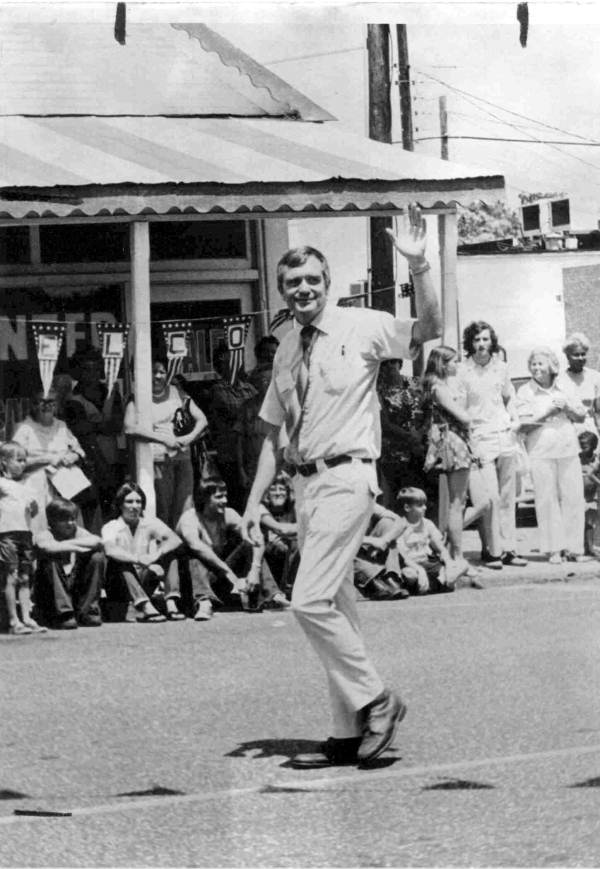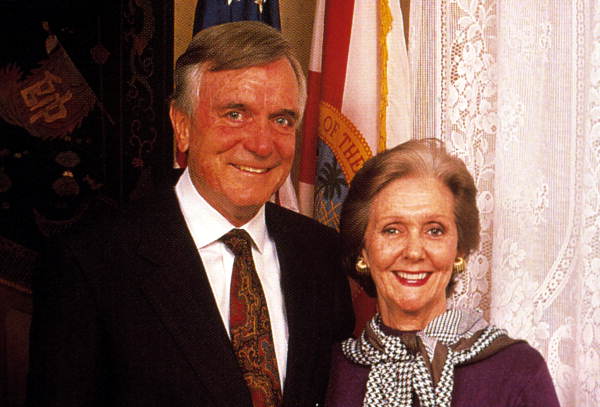Description of previous item
Description of next item
The Walking Senator
Published May 5, 2018 by Florida Memory
In the parlance of American politics, when someone is up for election to a public office, we say that she or he is running for that office. In 1970, however, a young state senator from Lakeland named Lawton Chiles decided he’d rather walk.
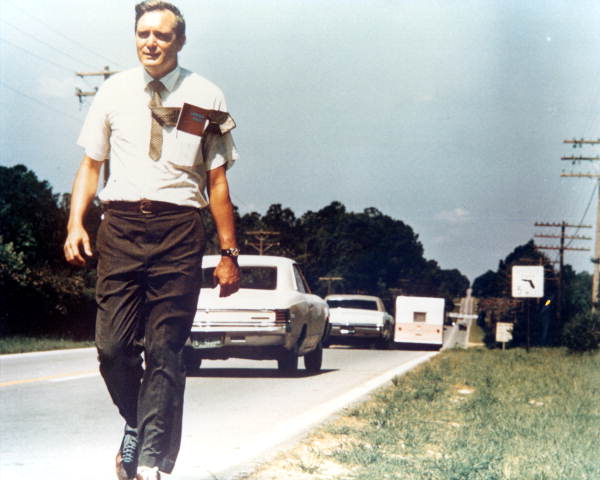
Florida State Senator Lawton Mainor Chiles Jr. walks along a Florida highway during his campaign for the U.S. Senate (1970).
Lawton Mainor Chiles Jr. was a Florida native, born in Lakeland in 1930 and educated at the University of Florida (UF). He served in the United States Army as an artillery officer during the Korean War before returning to UF for law school. Chiles graduated with his law degree in 1955 and opened up a practice in his hometown. Just three years later, at the age of 29, Chiles won a seat in the Florida House of Representatives, where he served through 1966, when he was elected to the Florida Senate.
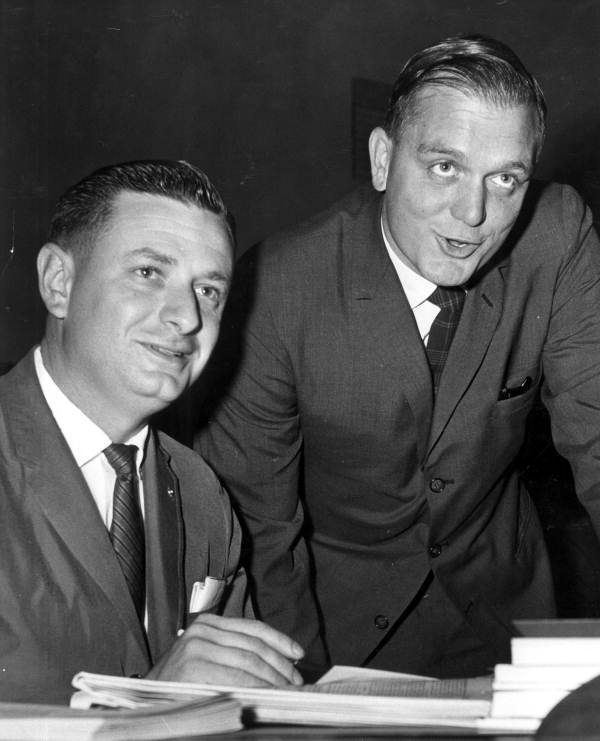
Representatives Don Fuqua (left) and Lawton Chiles (right) looking over a bill during the 1961 legislative session in Tallahassee.
But Chiles had his sights set even higher. In 1969, he announced his decision to run for the U.S. Senate seat being vacated by veteran statesman Spessard Holland the next year. Holland had been a fixture in Florida politics for decades, having served as a state senator in the 1930s and then governor during most of World War II (1941-1945). His U.S. Senate career had begun the very next year in 1946. After serving nearly 25 years in that capacity, he would certainly leave big shoes for his successor to fill.
Chiles believed he was up to the task, but he had some obstacles to overcome. Polls showed that only about four percent of Florida’s 2.7 million voters knew who he was. That problem would become even more pressing when former Governor C. Farris Bryant entered the race against Chiles for the Democratic nomination. Chiles needed voters to get to know him and his ideas if he was to have a shot at even making it to the general election. Moreover, he needed to get this publicity on a tight budget. As a younger, lesser-known candidate whose political career had mainly focused on one specific part of the state, Chiles lacked the far-reaching fundraising network that some of his opponents could draw from.
That’s where the idea for a statewide walking campaign came in. Rhea Chiles, Lawton’s wife, hatched the plan, according to later recollections from their son Bud. She suggested it at a strategy session at the couple’s home in Lakeland on March 12, 1970. A number of friends and political allies were skeptical and counseled against the idea. It took Chiles less than a day, however, to decide that a walking campaign was exactly what he would do. He explained that the concept dovetailed perfectly with the principles he laid out in announcing his decision to run for office–his determination to be a “working candidate” and talk with real everyday Floridians and learn about their desires, concerns and ideas.
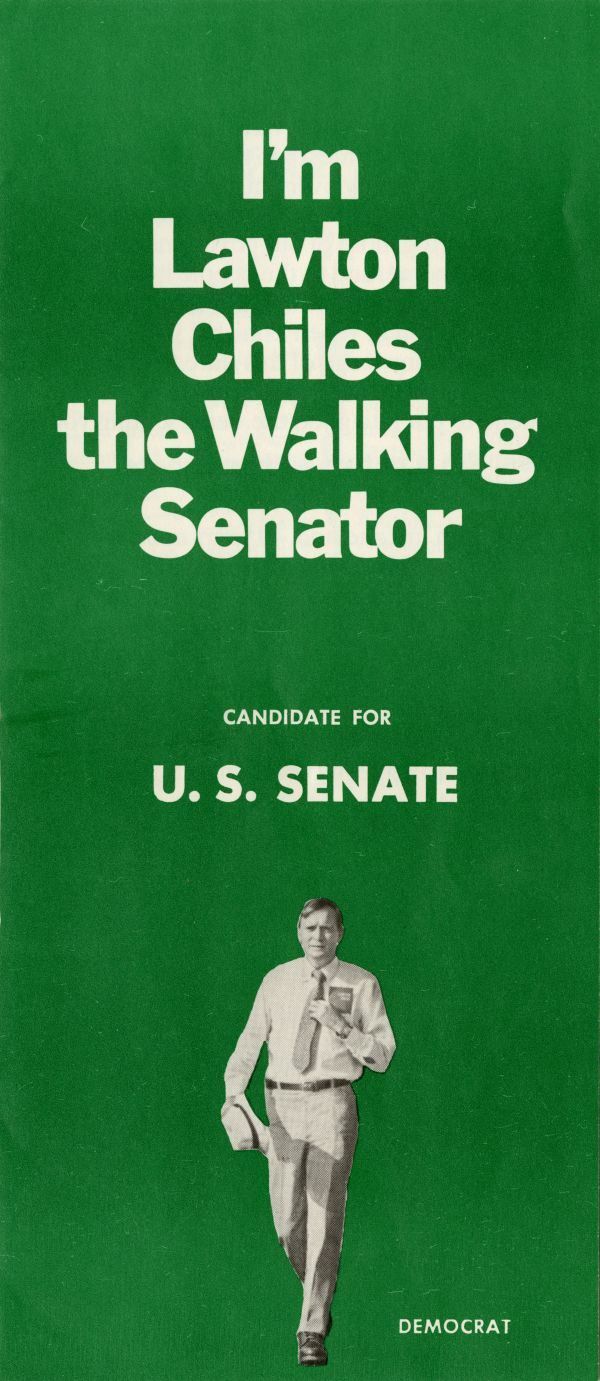
Cover of a brochure published by Lawton Chiles’ 1970 Senate campaign to explain Chiles’ decision to “walk” rather than “run” for office (State Library of Florida Campaign Literature Collection). Click or tap the image to view the complete brochure.
Chiles headed up to the Florida Panhandle and began looking for a logical spot to begin the walk. He and his supporters decided on Century, a small town in Escambia County, north of Pensacola on the Florida-Alabama line. The plan was to start in Century and end up all the way down in Key Largo, stopping for 60 days in Tallahassee for the 1970 spring legislative session. Chiles would walk the route six days per week and rest on the seventh. A camper would follow him with supplies and a place to rest, eat and sleep along the way.
The walk began on March 17, and it quickly became clear that Chiles had definitely gotten one thing correct: Floridians had a lot to talk about with this man who wanted to become their next U.S. Senator. Chiles reported having conversations with people on everything from the price of doing business as a small farmer to the war in Vietnam to school integration to the backlog of work remaining to be done on Interstate 10 through the Panhandle. And Chiles didn’t typically have to find people to talk to – they came to him. Campaign officials encouraged Floridians to walk alongside the candidate to share their ideas, and many did. Some even cooked meals for the campaign or hosted community events to welcome the Chiles caravan into town. The day-to-day events of Chiles’ journey are well-documented, both in newspaper articles and progress reports published by the campaign, copies of which are now in the State Library’s Campaign Literature Collection and available on Florida Memory. This map shows the route Chiles took from Century to Key Largo in pink, with some criss-crossing in the middle of the state. Click the map to zoom in on parts of the route.
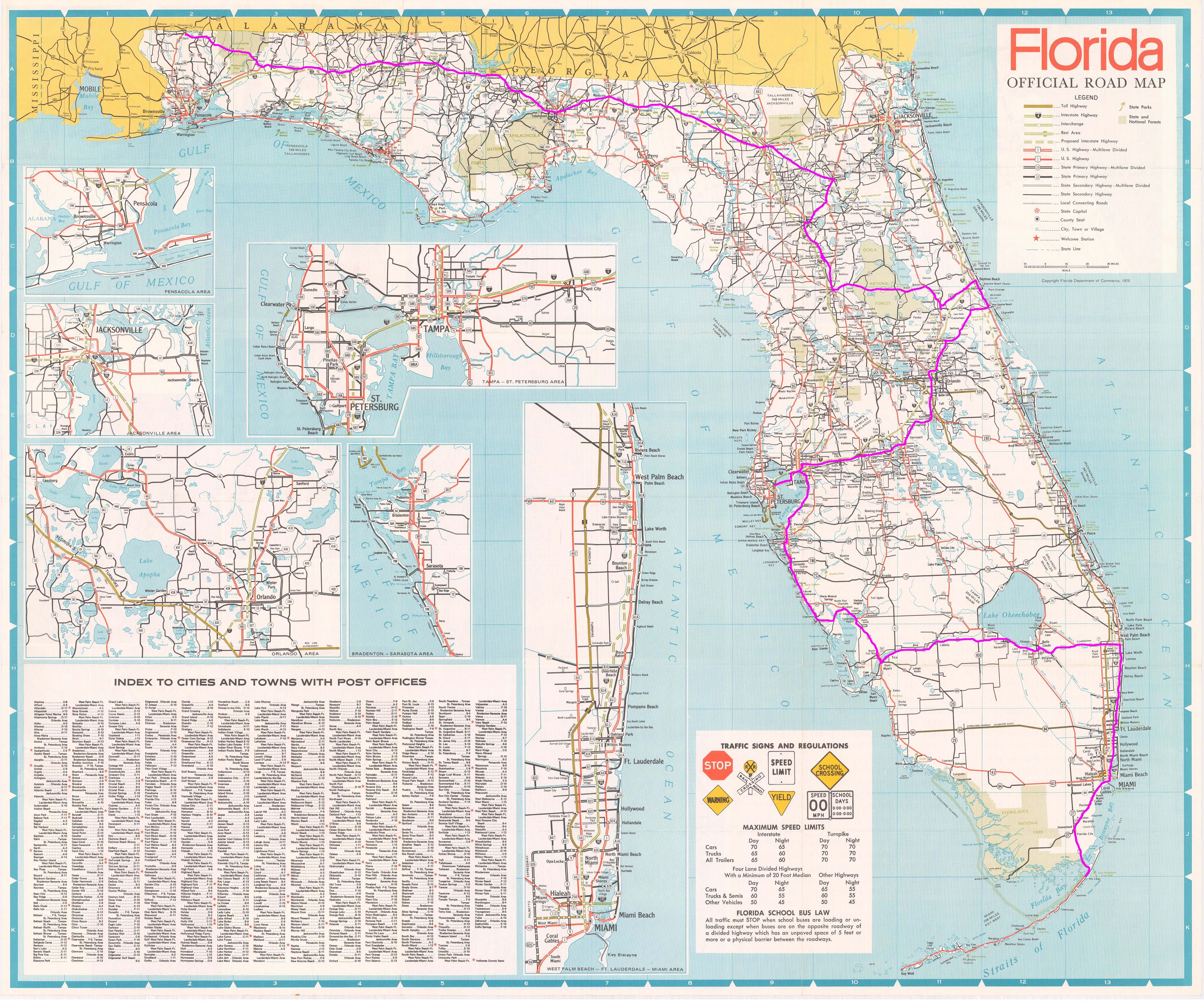
A 1970 Official State Highway Map showing the route of Lawton Chiles’ 1,003-mile walk between Century in the Panhandle to John Pennekamp Coral Reef State Park near Key Largo. Map courtesy of the Florida Department of Transportation.
Naturally, this method of campaigning had some pitfalls. Pop-up rain showers often forced Chiles to stop and change clothes throughout the day, and motorists didn’t always keep a safe distance as they passed him on the highway. The walking itself was taxing, and Chiles reported getting “stove up” like an old racehorse after just a few days on the road. His legs and feet gradually became more accustomed to the demanding task at hand, but that didn’t stop Floridians from showing their concern. People constantly asked him about his feet, and they sometimes brought out home remedies for blisters or underwear or other “helpful” gifts. One person gave Chiles a giant ball of twine for him to unwind as he went along so he would be able to find his way home.
Chiles’ journey across the state came to an end on August 19, 1970, when he walked into the John Pennekamp Coral Reef State Park in Key Largo. He had walked 1,003 miles in 91 days, going through five pairs of boots and losing twelve pounds and three inches from his waistline. He told a Miami Herald reporter who joined him for the last mile or so that he could hardly believe it was really over. “I wonder what I’m going to do tomorrow,” he said.
As it turned out, Chiles was about to have plenty to do. He qualified for a runoff with fellow Democratic candidate Farris Bryant, and clinched the Democratic nomination two weeks later on September 29. President Richard Nixon himself came to Florida to campaign for the Republican challenger, William Cramer, but ultimately Chiles came out ahead on Election Day and won a seat in the U.S. Senate. He would serve for three terms as senator (1971-1989) before returning to state government for two terms as governor (1991-1998).
Lawton Chiles died December 12, 1998, just three weeks before the end of his final term as governor. In a homage to the unique campaign that had introduced him to so many Floridians in 1970, Chiles’ funeral procession retraced part of the route of his walking tour, starting in Century and ending in Tallahassee, where his casket lay in state in the Old Capitol prior to his funeral. The Florida Legislature further honored Chiles’ memory by designating the entire route of Chiles’ 1970 walking campaign as the “Lawton Chiles Trail.” The route is now marked with signs depicting one of the most iconic artifacts of that journey–a well-worn pair of walking boots. Those boots, by the way, are on display at the Florida Historic Capitol Museum as part of the museum’s permanent collection.
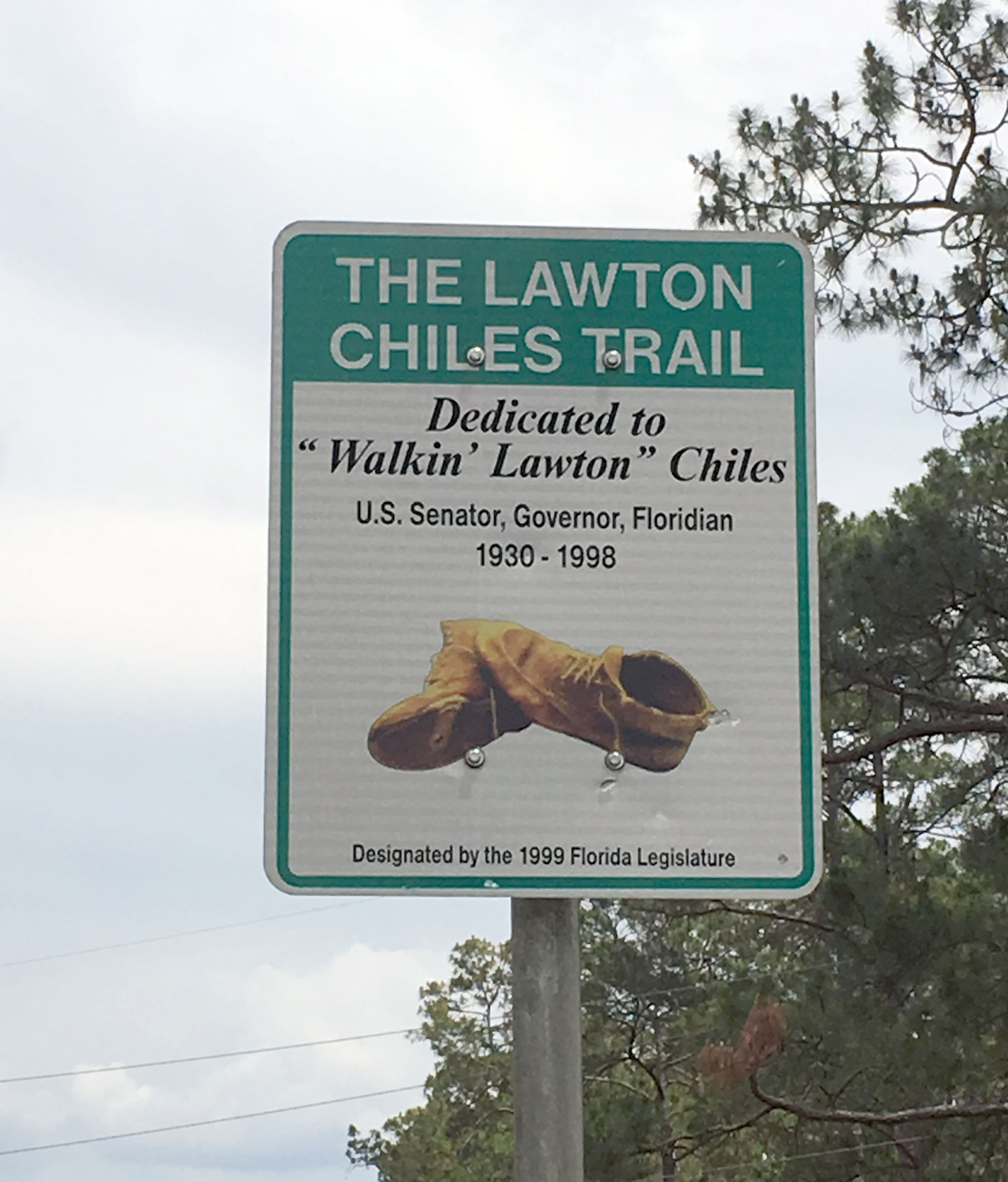
One of many signs marking the “Lawton Chiles Trail” designated by the 1999 Florida Legislature. This one appears on State Highway 100 just outside of Lake Butler (Photo courtesy of the author).
Search the Florida Photographic Collection for more pictures illustrating Florida’s colorful political history, and check out the State Library’s Florida Governors bibliography to find related books and other resources.
Cite This Article
Chicago Manual of Style
(17th Edition)Florida Memory. "The Walking Senator." Floridiana, 2018. https://www.floridamemory.com/items/show/333283.
MLA
(9th Edition)Florida Memory. "The Walking Senator." Floridiana, 2018, https://www.floridamemory.com/items/show/333283. Accessed December 30, 2025.
APA
(7th Edition)Florida Memory. (2018, May 5). The Walking Senator. Floridiana. Retrieved from https://www.floridamemory.com/items/show/333283

 Listen: The Blues Program
Listen: The Blues Program